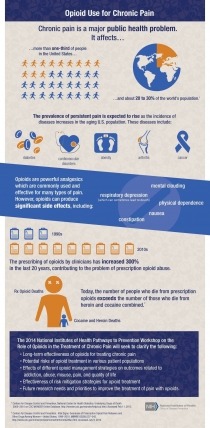Chronic pain affects an estimated 100 million Americans, or one third of the U.S. population, and it is the primary reason Americans are on disability. The increase in the prescribing of opioid pain relievers in recent decades has contributed to an increase in addiction to opioids and overdose deaths. NIDA is part of a team of public health institutions working to find solutions, which are starting to show some success. In April 2018, NIH launched its initiative Helping to End Addiction Long-term to improve our understanding, management, and treatment of pain, as well as to improve treatment for opioid misuse and addiction. Learn About NIDA’s role in the HEAL Initiative.
Looking for Treatment?
Use the SAMHSA Treatment Locator or call 1-800-662-HELP (4357).
Related Resources
- Opioid and Pain Management CMEs/CEs (NIDAMED)
- The Role of Opioids in the Treatment of Chronic Pain (Office of Disease Prevention)
- Neuroscience: Pain Detection (Video, 15:37) (Federal Judicial Center)
- Pathways to Safer Opioid Use (Office of Disease Prevention and Health Promotion)
- NIH Director’s Blog on Opioids
- NIH Director’s Blog on Pain
- NIH Pain Consortium
- Pain: Considering Complementary Approaches (eBook) (National Center for Complementary and Integrative Health [NCCIH])
- Pain: U.S. Military and Veterans (NCCIH)
- Nonopioid Treatments for Chronic Pain (CDC)
- Opioid Prescribing (CDC)
- Prescription Pain Medications (SAMHSA)
- Confronting Pain Management and the Opioid Epidemic (The National Academies of Science, Engineering, Medicine)



